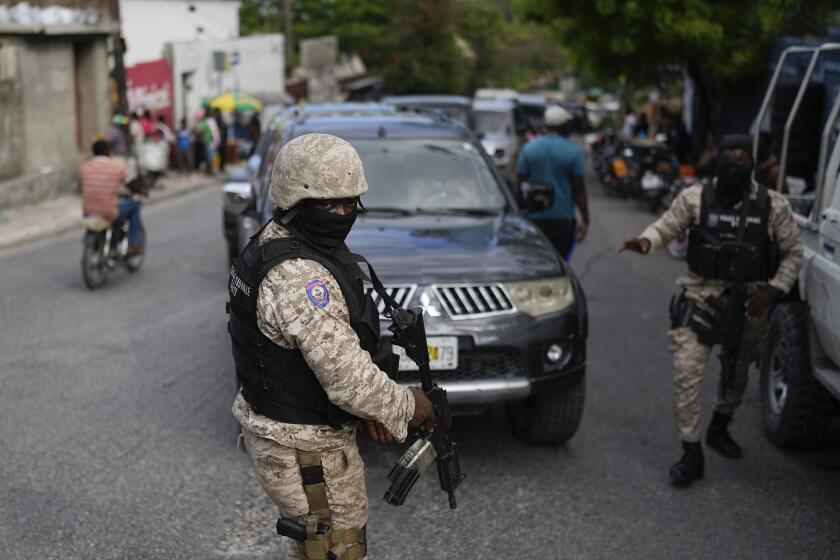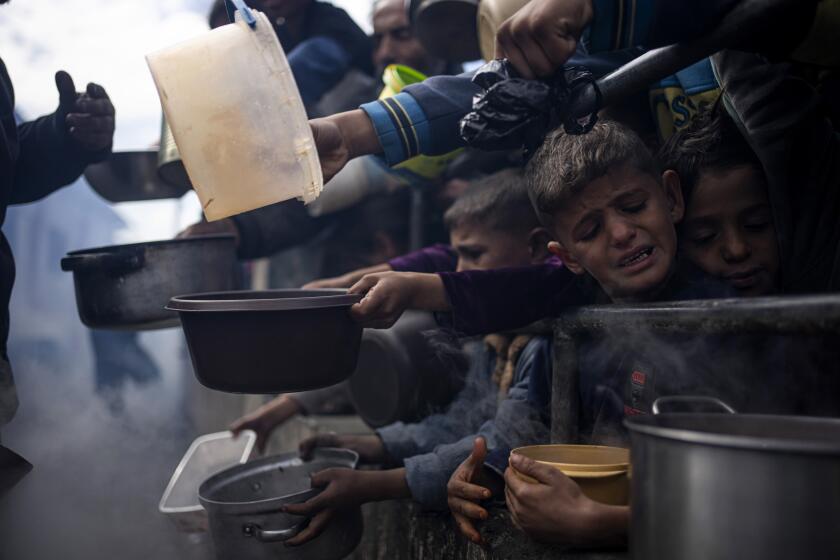Residents of Japan quake region wonder where the government is
There may be radioactive particles wafting out of the sky, but Masahiro Hamaguchi has a more pedestrian concern about the air around him: the dribble of cold, wet snow.
A week after the deadly earthquake and even deadlier tsunami that have devastated Japan, newly homeless huddle hungry and cold in emergency shelters. And people are wondering where their government is.
“I need something, anything, to warm my body,” said Hamaguchi, 58, a burly man trying to stay warm under a thin red raincoat. “I have no winter clothing. It was all destroyed.”
Photos: Japan grapples with crisis
The only clothing Hamaguchi found in his home overlooking battered Kesennuma Bay was some wet underwear. He stuffed them into a plastic bag that he strapped to his back with a red-and-navy striped necktie, a reminder of his job as a municipal bureaucrat, until his world imploded a week ago. In his arms, he carried a framed drawing of Kannon, the Buddhist goddess of compassion, a gift from his calligraphy teacher.
“I can’t worry about a cloud of radiation 120 miles away because the destruction is so big here,” he said, noting the lack of food, clothing, electricity, heat and telephone service.
Most victims have endured their privations with stoicism, but anger is rising over the lack of basic services.
For Hamaguchi and others, this is looking familiar. After a major quake in Kobe in 1995, organized crime groups were handing out blankets and food within hours; the government dithered for days.
Afterward, officials vowed to speed up decision-making and marshaling of resources to stricken areas in times of crisis.
“The Japanese government should have learned from the Kobe earthquake that they would need help, but they didn’t,” Hamaguchi said.
Aware of the political sensitivity, the government’s senior spokesman told Japanese to be patient, and asked the rest of the nation to accept sacrifices.
“It could take a very long time to restore things in the disaster area to the way they were before,” said Yukio Edano, Japan’s chief Cabinet secretary, urging people in Tokyo and elsewhere to reduce their electricity consumption so more is available in the quake area.
“I realize that this is very inconvenient for many people,” Edano said, “but many of the evacuees are without any heat and using blankets to keep warm. I also ask that people try not to use heat at home.”
Walking along the battered shoreline of Kesennuma and assessing the damage, Kit Miyamoto, chief executive of West Sacramento-based Miyamoto International, a structural engineering firm, said it appeared that Japan was totally unprepared for the disaster.
“It’s unthinkable, after several days, that there are still no supplies down here,” he said.
There were some signs of improvement Friday. Farther north along the coast in Miyako, a single lane had been ploughed through most debris fields, and food and fuel were starting to arrive in the shelters just as some of the displaced began to drifted back to their homes.
Kiyohiko Sasaki, a city official, said the number of people at a shelter set up in a junior high school had dropped from 100 to 60, and that some kerosene had arrived to for heating against the bitter cold.
But the community benefited from its geographical position, which made its power, water and road links somewhat less vulnerable to tsunami damage. And Tatsuyuki Kumagai, another city official, said blankets and such personal items as women’s underwear and toothbrushes were still badly needed, along with gas, electricity and water.
At the makeshift disaster center in Kesennuma, it was another day of frustration. Kimio Onodera ran his finger over computer printouts on a bulletin board of those housed at evacuation shelters, a shorter list of the known dead and a third series of handwritten messages.
The 45-year-old teacher said his family was safe. But his best friend’s parents were missing. With a gasoline shortage, his professor friend couldn’t travel the 150 miles to the region himself. So he asked Onodera to search for him, which he had been doing unsuccessfully for three days.
Onodera ticks off the shortages: fuel, water, phone service, electricity, kerosene, food.
“It’s been a week, and there’s still been no government help,” he said. “This is the best they can come up with? What the hell are they doing?
“My biggest anger is when government workers arrive in suits,” he said. “I’m a mess; look how we’re dressed. They’re not thinking, they’re not clever.”
In contrast, when a major earthquake hit China’s Sichuan province in 2008, a round-the-clock stream of aid vehicles and citizen volunteers brought tents, blankets and food to hard-hit countrymen.
But in almost any natural disaster, those most affected tend to think their government isn’t moving fast enough. Then too, Japanese officials have also been battling the related crisis at the stricken nuclear power plant.
“I don’t think on Day 6 of Hurricane Katrina things were going more smoothly,” said Neil Joyce, a volunteer physician from the Santa Monica-based civic group International Medical Corps, which had opened an operation in Sendai, the afflicted region’s major city, two days earlier. “If you look at this point after the Haiti earthquake, people were screaming: ‘Where is the water?’ It takes a while to get your ducks in a row.”
Even so, there are relatively few trucks and emergency vehicles evident on highways headed for the worst-hit areas.
At the Natori City Hall, Chizuko Nakajima, a government worker in the senior citizen department, watched a resident yell at her colleagues over the slow pace in rebuilding roads and other basic infrastructure.
Much of the mayor’s time is spent in meetings, she said, rather than conferring directly with the displaced. “They might yell at him in frustration if he did,” she said.
Hiroyuki Arate, a telephone industry worker struggling to restore mobile service this week, said more than 1,000 people were homeless in the Kesennuma area, including some being housed at a mountaintop refugee center.
“It’s cold. They don’t have electricity, power, water,” he said. “They can’t use the toilet. There are also no phone signals, so people have not been able to contact their worried families.”
“I’ve never experienced war,” he added. “But this is what it must be like. It’s hell.”
Photos: Japan grapples with crisis
More to Read
Start your day right
Sign up for Essential California for news, features and recommendations from the L.A. Times and beyond in your inbox six days a week.
You may occasionally receive promotional content from the Los Angeles Times.






